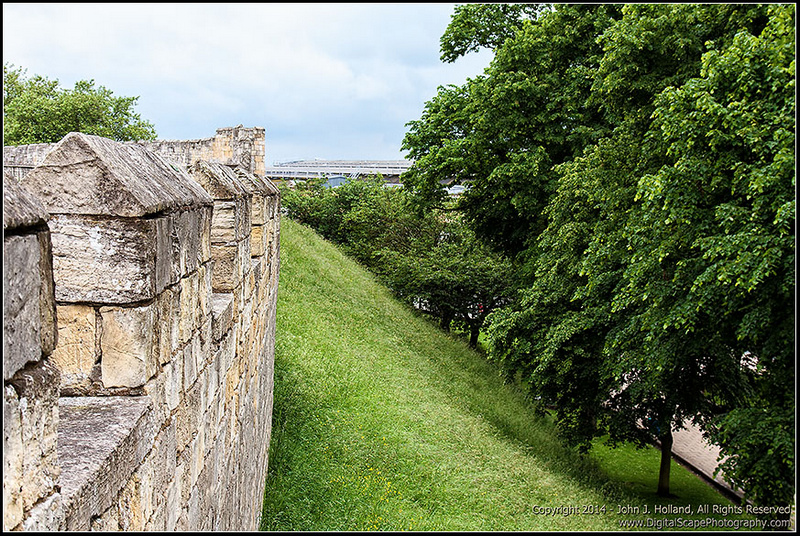Here is the same image with two different process variation. The first is pretty much SOC - levels, curves, and sharpening
I then took the same image and made several versions of the image by varying only the exposure value in the RAW processor. I then blended the variants into a single image - a pseudo HDR (or blended exposure). this brought out more of the clouds and the texture of the wall.
Results 1 to 9 of 9
Thread: York Wall - Process Variations
-
18th June 2014, 08:20 PM #1
York Wall - Process Variations
-
18th June 2014, 09:20 PM #2

- Join Date
- Jan 2009
- Location
- South Devon, UK
- Posts
- 14,559
Re: York Wall - Process Variations
Combining 2 or more variations of Raw conversions is something which I do frequently, John. Maybe not true HDR but much more acceptable to shoot when you have movement in the scene.
Your edit has worked well; although I wonder about an additional Curves adjustment to selectively add just a fraction more contrast to the wall?
-
18th June 2014, 11:02 PM #3

- Join Date
- Jun 2013
- Location
- North West of England
- Posts
- 7,178
- Real Name
- John
Re: York Wall - Process Variations
Why isn't this true HDR? (serious question because I have often wondered.)
John, I prefer the second image for the wall but not the grass or trees. Might be worth layering the second over the first if you can and then cutting through to the greenery either with an eraser or using a mask.
-
19th June 2014, 01:48 AM #4
Re: York Wall - Process Variations
Nice efforts, each lends a little something to the image, for instance cloud development in second and texture of trees in the first. Further combinations could be explored.
-
19th June 2014, 07:13 PM #5

- Join Date
- Jan 2009
- Location
- South Devon, UK
- Posts
- 14,559
Re: York Wall - Process Variations
Being the only person here not called John.

I will try to give an explanation of why this method isn't true HDR. With that technique several shots are taken with different exposures so each one is specifically taken for a particular place in a widened tonal range. So it gives a good and clear expanded range when they are merged.
With several alternative options, a single shot which has a confined range is processed in different ways to 'stretch' the apparent overall range. But will never have the full tonal range of a number of correctly taken shots.
However, as I previously mentioned, there can be limitations to actually shooting a number of shots; so in those cases something like the method used here is often an acceptable alternative.
How well it works tends to depend on the actual tones in the original scene. For a fairly dull scene it can work very well but where there is a wide range such as bright sunshine and deep shadows you won't get quite the full range.
-
20th June 2014, 01:20 PM #6
Re: York Wall - Process Variations
Thank you for the comments and feedback Geoff, and John, and John. I think the second image needs a bit more tweaking as well - not satisfied with the way the trees turned out on the right side of the frame.
Another reason why I did an exposure blend on this image (rather than doing a multiple shot HDR), is I was shooting hand held, leaning out over the way - no way to set up a tripod (and I was not carrying an tripod anyway).
-
20th June 2014, 02:11 PM #7

- Join Date
- Dec 2013
- Location
- Turkey
- Posts
- 12,779
- Real Name
- Binnur
Re: York Wall - Process Variations
Hi John (Digitalscape), may I ask how you combined the images in PS? Something like focus stacking or which function?
-
21st June 2014, 01:08 PM #8
Re: York Wall - Process Variations
Binnur,
I start out with the single image and process it "normally" (i.e. my usually procedures). After having a "base" image, I then make several variants by adjusting the exposure setting (I am working with a RAW image and doing the variants via Photoshop Bridge). Saving the variants as TIF files I then load them into Photomatix (www.hdrsoft.com) to blend. I made a couple different blended versions in Photomatix and then load the "base" an the blended variants back into Photoshop as individual layers. I then adjust the layer opacity, and if needed add layer masks to the blended variants to generate the desired result.
There are other methods of doing this - lots of ways of achieving nearly the same result in Photoshop. You can also try duplicating the "base" layer and change the blending mode to "Multiply", adjust the opacity and add a layer mask for additional control.
-
21st June 2014, 03:47 PM #9

- Join Date
- Dec 2013
- Location
- Turkey
- Posts
- 12,779
- Real Name
- Binnur
Re: York Wall - Process Variations
Hi John, it is clear to me now. I thought you did everything in PS and that's why I was confused. It is a bit early for me to deal with HDR but I'm interested in it. Thanks for the link, I have already known about it for some time , but I don't have the software (photomatix) yet. As I said, it is a bit early for me. For the time being, it is better for me to work with layers and masks as you suggested. Thank you very much


 Helpful Posts:
Helpful Posts: 


 Reply With Quote
Reply With Quote
